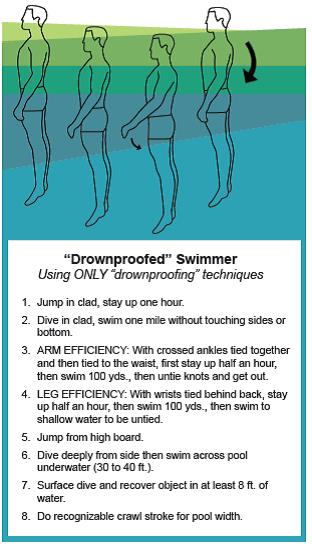If you wanted to learn how to survive in the water, Georgia Tech had just the course for you. From 1940 until 1987, drownproofing, a method for surviving in the water for long periods of time, was a required course for Georgia Tech students. Coach Freddy Lanoue, who taught the class until the mid-1960s, developed the drownproofing technique in response to events happening in the world at that time. He indicated that more navy sailors had drowned during World War II than were killed by artillery fire because they could not survive in the water for long periods of time if their ship was sunk.
The objective of the course was for the student to be able to float in deep water for as long as he could stay awake. For most, this could be well over 24 hours. The key to survival is to be able to vertically lie in the water with only the top of your head exposed. It’s possible to float this way because most individuals’ body density is 98% water. The process is to take a deep breath, let your body go limp while 98% of it is submerged, let out about a third of your breath, and allow yourself to “hang” in the water. When you are ready for another breath, exhale, and move one arm or leg enough so that you can lift your head out of the water and take another deep breath. Again, let your head submerge with only the top back part of it above the water line. By repeating this procedure, you can float in the water as long as you can stay awake.
Throughout the course, we had several tests, including the first test which was to tie your hands behind your back and your feet at your ankles, drop into the deep end of the pool, and float for one hour. We all felt that if we could pass that test, we could not only pass any swimming test, but we could pass any test in any school at Georgia Tech! Each student had a partner when we took the tests. The partner would jump into the pool and pull us out of the water if our heads went under and we were not able to make it back up to the top. This kept us from drowning!
My partner was a heavyset boy who was a football running back in high school. His body was denser than water; therefore, when he went limp, his body would sink! The first time he did the first test with his hands and feet tied, he sank nine times in a row and I had to go in and pull his head up and out of the water to keep him from drowning. Coach Lanoue would not let me go in until my partner was almost out of breath. After attempting the first test, I recall my partner yelling as he came out of the water, “Where the ‘H’ were you? I almost drowned!”
With his heavy body density, he had to fight through every test. When he completed the course, Coach Lanoue gave him a good grade because he kept fighting and never gave up. Over the years, I have found that life is a lot like that swimming course.
Written by: Paul Flood, IE 1958, chairman and CEO of Chattahoochee Health Resources. His clients include hospitals, state hospital associations, and large physician practice groups. Flood continues to stay in touch with Georgia Tech, and has served on the ISyE Advisory Board since 2012.
This article first appeared in the Fall 2013 ISyE Alumni Magazine.

